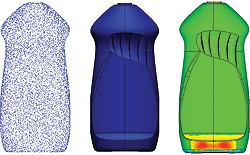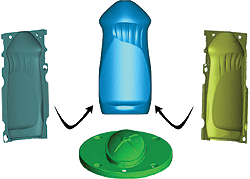SITUATION

Point Cloud, CAD and Colormap Inspection
Companies working with molds must often make changes to the shape of tooling right on the shop-floor. These continuous improvements are necessary to avoid delays in production due to imperfect manufacturing results. However, these hand-finished changes result in a mismatch between the tooling’s original CAD model and the actual physical mold.
One of the world’s leading liquid packaging firms made shop-floor changes to the tooling of a soap bottle to adjust the volume of liquid the bottle holds. They needed to determine where the CAD data differed from the physical mold, and then modify the model accordingly.
SOLUTION

Soap Bottle Digital Assembly
The client contracted our team to scan the mold, identify changed areas, and then modify their CATIA CAD model to reflect the identified changes. Scanning the mold required several steps – accurately scanning the three pieces, assembling them digitally and trimming the excess to capture the negative space. The digital assembly enabled our team to extract the actual shape of the bottle from the molds.
Our company used Rapidform to generate a colormap deviation report and a cross section analysis using the overlay of the two models, which visually highlighted modified areas. These inspection reports gave our team the data needed to make the appropriate revisions to the client’s CAD data.
RESULTS

Our team’s scanning services provided the client with exactly what they needed – an updated CATIA model that reflects the shop-floor changes their customer desired. The client’s only practical alternative to 3D scanning would have been to redesign the tooling – a solution that risks having a different shape and volume of bottle. Our team’s services empowered them with a cutting-edge way to solve their engineering problems, offering high quality results with little risk. Impressed with the project’s results, this client continues to work with our team for all their scanning, inspection and reverse engineering needs.
